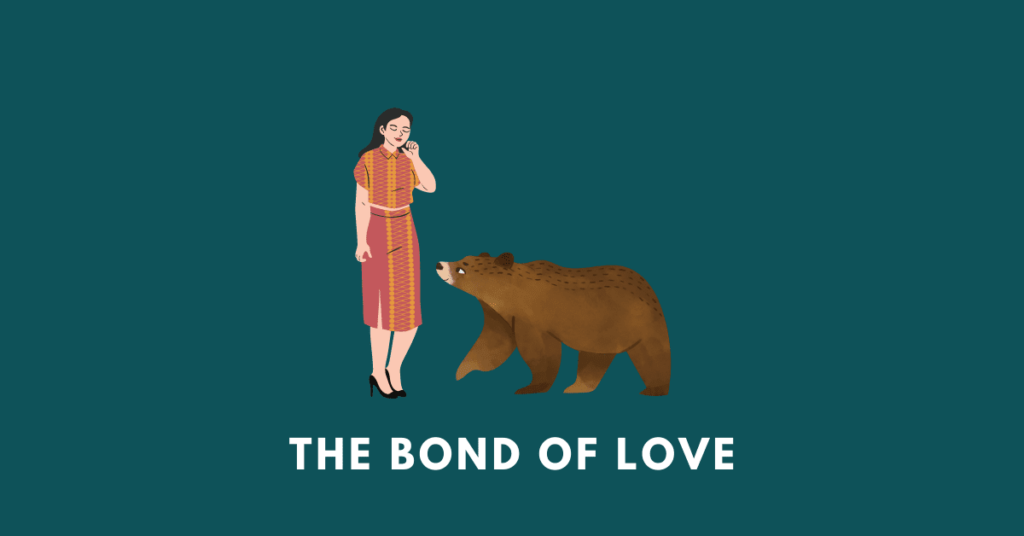Get summary, textbook solutions, questions, answers, notes, extras, MCQs, pdf of the chapter “The Bond of Love” by Kenneth Anderson for SEBA, (Assam Board) and TBSE (Tripura Board) Class 9 English (Beehive). However, the given notes/solutions should only be used for references and should be modified/changed according to needs.
Summary
“The Bond Of Love,” by Kenneth Anderson, portrays the profound bond of emotion that can exist between a man and a wild animal.
Anderson and his friends were once travelling through sugarcane fields near Mysore when they came across wild pigs being chased out of the fields. They brought out their guns and while some were killed by gunfire, others fled. They believed all was finished until a black sloth bear arrived out of nowhere and was fatally shot by one of the author’s companions. They eventually noticed that a baby bear had been riding on the back of the deceased mother bear. The distressed little cub made a sad cry as it went around its lifeless parent.
Anderson attempted to trap the cub, but it fled into the sugarcane fields, where it was pursued and eventually caught by the author. His wife was overjoyed when he presented her with the young bear. She immediately wrapped a colourful ribbon around its neck and named it Bruno after finding it was a boy cub. The young bear began by drinking milk from a bottle but quickly began to eat a variety of foods. Porridge, vegetables, fruit, nuts, meat, curry, rice with or without spices, bread, eggs, chocolates, sweets, pudding, ice cream, and so on. Bruno drank a variety of beverages, including milk, tea, coffee, lime juice, aerated water, buttermilk, beer, and alcoholic beverages. Everything went down smoothly.
Bruno developed strong attachments to the family’s two Alsatian dogs as well as the tenant’s children. He had unlimited freedom, playing and moving around in every room of the author’s home, including the kitchen, and even sleeping in their beds.
Bruno was involved in an accident one day. He went into the library and ate some of the poison barium carbonate that the author had placed in the library to kill the rats. Bruno suffered a paralytic attack shortly after taking the toxin. He did, however, manage to contact the author’s wife, who immediately alerted her husband. Bruno was transported to a veterinary doctor right away, who gave him two antidote injections of 10 cc each. Bruno recovered quickly and resumed normal eating habits. Bruno drank old engine oil that the author had saved as a termite repellent at another time. He, however, was unaffected.
Bruno was well-cared for by the author’s family, and he grew quickly, becoming many times his original size. He’d turned mischievous and amusing. Bruno adored the author’s family, but above all, he adored the author’s wife, and she adored him! The author’s wife gave him the name Baba, which means “little boy.” He learned a few tricks as well, but he was still shackled due to the children of the tenants.
Bruno had grown too large to be maintained at home, and the author and his son, as well as their friends, decided that he should be given to a zoo. After great effort, the narrator’s wife, who had developed a strong attachment to Bruno, was persuaded. After receiving a good response from the curator, the bear was sent to the Mysore Zoo.
Even though the author and his family missed Bruno terribly, they were relieved in certain ways. His wife, on the other hand, was upset. She cried, worried, and refused to eat. Meanwhile, the curator and the narrator’s friends who visited the zoo reported that Bruno, while healthy, was unhappy and not eating. The author took his wife to the zoo after three months, at the request of his wife.
Bruno immediately recognised the author’s wife and expressed his joy by howling. The author’s wife asked the curator to return Bruno to her after spending three hours feeding and stroking him. He then advised her to speak with the superintendent. Bruno was finally allowed to return home with the Superintendent’s consent. An island with a dry pit or moat surrounding it was built specifically for him to keep him comfortable and safe. On the island, the author’s wife would spend a lot of time with Bruno in her lap. This demonstrated that sloth bears, like humans, have feelings, memories, and unique features.

Textual questions and answers
Answer the following questions.
1. “I got him for her by accident.”
(i) Who says this?
Answer: The narrator is the speaker of the above-quoted statement.
(ii) Who do ‘him’ and ‘her’ refer to?
Answer: In the above sentence, Bruno the sloth bear is referred to as “he,” while “her” refers to the narrator’s wife.
(iii) What is the incident referred to here?
Answer: The incident that is being discussed here is the story of how the narrator met Bruno. A friend of the narrator happened to shoot a black sloth bear while passing through sugarcane fields near Mysore, and as they watched the fallen animal, they discovered that beneath its thick fur was hidden a baby bear. After that, the narrator grabbed the baby bear and handed it to his wife as a pet.
2. “He stood on his head in delight.”
(i) Who does ‘he’ refer to?
Answer: ‘He’ refers to Bruno in the above statement.
(ii) Why was he delighted?
Answer: Bruno was delighted because the narrator’s wife had come to pay Bruno a visit at the zoo. For more than three months, he had been separated from her.
3. “We all missed him greatly: but in a sense we were relieved.”
(i) Who does ‘we all’ stand for?
Answer: Here, ‘We all’ in the preceding sentence refers to the narrator and his family.
(ii) Who did they miss?
Answer: Bruno, their sloth bear, was missed by everyone.
(iii) Why did they nevertheless feel relieved?
Answer: Bruno had gotten rather huge and had to be kept tied up most of the time since he presented a threat to the tenant’s children, so they were relieved when the zoo authorities took him away. As a result, Bruno’s transfer to the zoo provided him and the narrator’s family with freedom.
Answer the following questions in 30 to 40 words each.
1. On two occasions Bruno ate/drank something that should not be eaten/drunk. What happened to him on these occasions?
Answer: The first time Bruno ate barium carbonate meant to kill rats, he did so by accident. He became paralysed and had to be taken to the veterinarian right away. Due to his vomiting and heavy breathing, he suffered until the vet injected him with the antidote. On the second occasion, Bruno drank nearly a gallon of old engine oil, but fortunately, he did not suffer any ill effects from it.
2. Was Bruno a loving and playful pet? Why, then, did he have to be sent away?
Answer: Bruno was a highly affectionate and energetic pet. Bruno had to be ejected from the residence due to his excessive size. He had to be chained for the most part since he was a danger to the kids. As a result, taking him to the zoo would provide him with his own place to explore.
3. How was the problem of what to do with Bruno finally solved?
Answer: Bruno, like her, was clearly unhappy at the zoo and missed the narrator’s wife. The narrator then took him home, built an island in the middle of the courtyard surrounded by a dry moat, and stacked all of Bruno’s necessities and toys on it.
Extra/additional questions and answers/solutions
1. Who in your opinion, had the strongest bond with Bruno? Give an example.
Answer: The narrator’s wife was Bruno’s closest friend. When Bruno was taken to the zoo, he refused to eat and was distraught. Bruno was eventually returned to the family home, and a private island was built for him at her request and initiative. She used to visit Bruno on his island by swinging across the moat on a rope. Bruno, on the other hand, was equally affectionate towards her and reciprocated her feelings for him.
26. How would the wife of the narrator go to Baba’s island?
Answer: The narrator had tied a rope with a loop to an overhanging branch of a mango tree. His wife would span the six-foot-wide pit surrounding the island by putting one foot in the loop and kicking off with the other. She would then sit in a chair for hours with Baba in her lap.

Ron’e Dutta is a journalist, teacher, aspiring novelist, and blogger. He manages Online Free Notes and reads Victorian literature. His favourite book is Wuthering Heights by Emily Bronte and he hopes to travel the world. Get in touch with him by sending him a friend request.
Get notes of other boards, classes, and subjects
